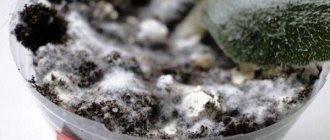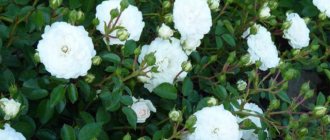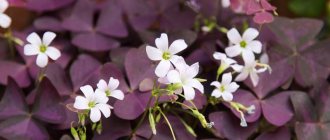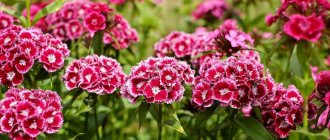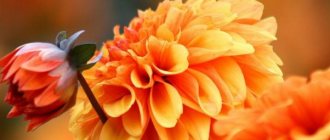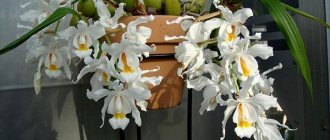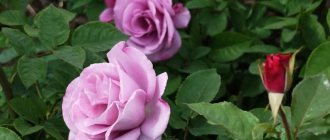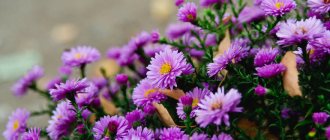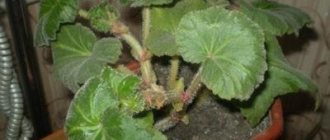Dahlias are luxurious flowers on a tall stem that bloom at the end of summer and delight the eye for a long time. There are many legends about this plant, according to one of which, the flower grew after the Ice Age, on the site of a extinct fire.
The historical homeland of this plant is Mexico. There, dahlias grew in mountainous areas. The Aztecs used their tubers for food; in Europe, dahlias did not receive recognition as a food product, but their beauty was recognized here.
Characteristics of dahlias: varieties and varieties
The culture can be roughly divided into annual dahlias (planted in flowerpots to decorate verandas) and perennial dahlias (placed in gardens and flower beds). Each group has its own characteristics, which relate to the principle of planting, appearance and care.
Blooming dahlias
Important! Basically, the difference lies only in the parameters of the aerial parts and buds.
Perennial bushes are very tall and lush. They can grow in one place for more than 2 years. Annuals have miniature forms (usually a low-growing herbaceous base) and are sown as a temporary decoration.
Varieties of varieties
Another difference is the shape of the flower, which determines the main groups of varieties:
- Simple - consist of 1 row of petals and an open center. Outwardly they resemble a colored chamomile. Basic varieties: Princess Marie Jose, Yellow Hammer, Orangeade.
- Anemone-shaped - have several rows of marginal and internal petals. They include varieties such as Lucy, Vera Higgins, Comet.
- Collared - have one row of marginal petals and internal, twisted shape. Varieties: La Gioconda, Chimborazo, Claire de Luna.
- Peony-shaped. The name fully matches the appearance. The most popular varieties are: Symphonia and Fascination.
- Decorative group - represented by varieties David Howard, Thames Valley, Jocondo.
- Globular - Crichton Honey, Doreen Hayes and Esmonde.
- Pom-poms - differ in different colors, among which there is only a blue tint. Varieties: Hallmark, Willo's Violet and Noreen.
- Cactaceae – Visit, Danny, Pirouette, Doris Day.
- Semi-cactus – Yellow Mood, White Swallow, Nantenan, Autumn Fire.
- Nymphaeaceae - they are also called lotus-shaped because of their resemblance to the flower of the same name. Main varieties: Gery Hawk, Genette and Brushstrokes.
Annual varieties
The mixed group has the largest number of different varieties.
Which variety should I choose?
Before planting, you should familiarize yourself with the varieties of annual dahlias with photos and names. Some of them will not grow more than 20-20 cm (short), so they are not suitable for decorating bouquets. Tall varieties can reach up to 70-90 cm in height and can form a real hedge. Among the most popular varieties of annual dahlias are:
- Figaro is a low bush (up to 45 cm), on which lush multi-colored inflorescences are formed;
- Piccolo is another low-growing bush (up to 40-45 cm), the flowers of which have a clearly visible core and petals;
- Unwins Dwarf is a taller plant, can reach 60 cm.
Growing annual dahlias is an easy way to get colorful flowers without much effort or preparation. Tall plants make beautiful bouquets or hedges, while low-growing annual dahlias form small borders. They are easy to care for and do not require winterization or fertilization. In addition, the seeds of the plant can be collected independently and left for planting next season.
Planting a plant
Dahlias, planted and cared for according to a simple scheme, bloom almost all summer until late autumn. To achieve a riot of colors, it is important to plant flowers correctly.
Planting by seeds
Dahlias Cheerful guys - planting and care
Mostly annual dahlia is planted with seeds. This herbaceous plant has a neat above-ground part. The trunk reaches 30-40 cm in height. Such hybrids bloom profusely and for a long time and are suitable for growing in flowerpots.
Note ! There are two options for sowing: in open soil and in pots with further planting in a flower bed. The first one is more popular, since the seedlings are resistant to adverse weather conditions.
Germination of seeds
How to plant dahlias with seeds:
- Choosing a location. The culture is sun-loving, so it should be placed in an open area.
- Sowing is carried out in May. The plant loves warmth, so you need to focus on the weather.
- Land preparation. It is worth choosing loamy soil. Slightly acidic or neutral soil is suitable. You must first add compost and mineral fertilizers.
- Soaking seeds. They need to be soaked in a fungicide solution to protect them from disease and rot.
- On a flat area, make grooves 2-3 cm deep at a distance of 30-40 cm from each other.
- Place the seeds along the groove at a distance of 30-40 cm. Sprinkle the planting material with soil and water.
- To speed up germination, the bed should be covered with film or glass. When the first shoots appear after 2-3 weeks, the shelter is removed.
Sprouted seedlings
When sowing seeds in a container, the algorithm of actions is the same. True, planting can begin in March-April, since germination will be carried out in greenhouse conditions or indoors.
Planting seedlings
When planting seedlings, you need to choose exclusively sunny areas, but protected from drafts and wind. The soil must be fertilized in advance and well loosened. Sprouts are planted in late May or early June.
The process of planting seedlings:
- Prepare the wells. The depth and width should correspond to the size of the root system of the seedling. The distance between the recesses must be at least 40 cm.
- Lay the sprouts horizontally and dig in so that the root collar is covered with 3-5 cm of soil.
- Water the seedlings generously.
- Cover with film until the temperature at night stops dropping below 10 °C.
Seedlings in open ground
The flower grows quickly, so you need to constantly monitor the height of the film. Otherwise, the trunks will be deformed and will be located horizontally in relation to the ground.
Planting dates for ungrown and grown tubers
Dahlia planting dates
Planting dates depend on the region and weather conditions. Dahlias are heat-loving and fast-growing plants, so there is no need to rush into planting in the ground - there is a high risk of damage from return frosts. You need to wait until the soil warms up to 22–25°C so that the cold-sensitive roots are not damaged.
Unsprouted tubers are planted earlier: in the southern regions - at the end of April, in the Middle Zone - in the last ten days of May, in the northern regions - in the first half of June .
Sprouted tubers , as well as rooted cuttings in the middle zone are planted in the first ten days of June; in the south of Russia this can be done in the second half of May . At first, monitor the air temperature and, if there is a threat of a drop, protect the sprouts with covering material.
Dahlias are planted in such a way that flowering does not occur in the hottest months (July-August). At this time, flowers grow poorly and suffer from overheating and low air humidity. Dahlia flowers become smaller and their color fades. Plants that bloom in May-June or in the autumn months develop large flowers on long stalks.
Watering and loosening the soil
Garden azalea - planting and care in open ground
Caring for dahlias after planting consists of watering the plant and loosening the soil. How to do it correctly:
- When the above-ground part is 10-12 cm high, hilling needs to be done. Form a slide around the trunk. This will help it take root better by sending out additional shoots.
- Watering is carried out once a week, because the crop is drought-resistant. The ground should get wet 30 cm deep. Artificial watering is stopped from mid-August.
- After each watering, you need to renew the hill around the trunk and loosen the soil in the hole. This will help protect the root system from rotting and provide a normal supply of oxygen.
Watering the plant
Note! Hilling is carried out several times per season. The need arises when the position of the bush relative to the ground changes.
To prevent the soil from drying out, you can lay mulch in the hole. But you shouldn’t get carried away - the layer should be minimal. Periodically, you need to remove the mulch to ventilate and loosen the soil.
In addition to watering and caring for the soil, an important rule is the formation of supports for the bushes. The basis for the tether is driven into the ground when planting the seedlings. Do not forget about trimming excess branches and leaves.
Water requirements
It is better to prepare moisture for irrigation in advance in order to soften its hardness and remove hazardous substances. To do this, gardeners use various methods, the main ones of which are:
- Settling in an open container in the middle of the site or inside the greenhouse for at least 12 hours. At the same time, caustic volatile elements such as chlorine erode, and heavy metal salts sink to the bottom. Before use, the liquid is carefully drained, not completely, leaving a sediment.
- Rainfall collection - during thunderstorms, water is collected in wide containers and then used to irrigate dahlias. There are also caveats here; it is better to collect precipitation in an environmentally friendly area, outside the city limits.
It is not recommended to use water from wells and wells directly, since it is too cold, and the delicate root system is not able to perceive such moisture. Watering with ice water will cause the plant to become thirsty, even if the soil appears damp, and may dry out completely.
Reproduction methods
Sill planting and care in open ground
Dahlia can reproduce in five ways. Each option has advantages and disadvantages, and some are used extremely rarely. Methods of propagation of culture:
- Dividing tubers. The simplest option that will allow you to preserve all the qualities of the mother bush. In the fall, you need to remove the tubers from the ground, wash them, remove dead roots and separate the tubers with your hands. As a result of division, each tuber should have two buds left.
- Vaccination is an infrequent, but very effective type of propagation. Make a conical hole in an old tuber. Sharpen a healthy dahlia sprig and insert it into the tuber. Wrap the joint with cotton wool. Plant the graft into the ground.
- Sowing seeds. This propagation option allows you to get a completely new plant (maternal characteristics are not preserved). When the flower begins to fade, you need to cut it and dry it indoors. Next, the planting material is collected and packaged until spring.
- Cuttings. The method makes it possible to obtain strong plants with high resistance to disease. At the beginning of March, healthy tubers are planted in a box. Proper watering and maintenance is carried out. When the tubers grow, a cutting will appear. After 2-3 internodes appear on the cutting, it can be cut off. Place the sprout in a container with sand.
- Disputes make it possible to obtain a new variety. Cut off a flowering branch and plant in a separate pot. Gradually reduce watering and let the branch dry out. For the winter, place the container in a room with a temperature of 6 °C. In the spring, resume watering in order to plant the bush in open ground in May.
Reproduction methods
Thanks to different propagation methods, it is possible to obtain not only a large number of young bushes, but also completely new varieties.
Selection of planting material
In addition to the variety and size of inflorescences, when purchasing, you must carefully select planting material. Dahlias can be planted by seeds, cuttings (tubers) and seedlings.
Seeds: The package indicates the dahlia group and plant height. It is very easy to grow a flower from seeds; it begins to bloom 45-50 days after planting.
You can buy flower seedlings. The seedlings are quite easy to care for; you just need to water them on time. In the fall, many form nodules that can be preserved until next year.
Most often, divisions (tubers) are used for planting dahlias in the spring.
Selection of dahlia tubers
When purchasing in sections, you need to carefully study the planting material. It is necessary to pay attention to the size of the tuber and the location of the renewal buds.
- Root tubers should be dense and elastic.
- A healthy tuber is light brown in color.
- There must be a piece of last year's stem.
- The root collar (the place where the root turns into a tuber) must be intact and intact. If it is frayed or blackened, the tuber will not germinate, since sprouts form in the immediate vicinity of the root collar.
- If the tubers are divided, then they must have growth points.
It happens that the tubers are covered with young white roots. They can be purchased, but must be planted immediately.
When choosing, you need to pay attention to the label and packaging. In addition to the picture (as a rule, the appearance of the flower is selected from it), the manufacturer puts information on the size of the flower on the packaging (indicated at the top in Latin letters) and the height of the plant is indicated.
If the bag is too light in weight, most likely the tubers have dried out; you can try to bring them back to life by placing them in damp sawdust or water. Although this may not help. Therefore, it is better to refrain from purchasing such planting material.
You should not buy:
- large “nests” of root tubers - many leaves develop from them, but few flowers.
- division with shoots - such a plant will begin to grow even before planting in the ground.
You can often find old pieces on sale. They are easy to distinguish - they differ in size and have a wrinkled surface. They can be used for flowering. But you won’t be able to get new planting material from them.
How to preserve tubers before planting
Dahlia tubers do not like dampness and can rot from excess moisture, or dry out in a hot place. Until planting, it is best to store in a dark, cool place (for example, in the refrigerator, wrapped in damp paper).
Tubers are also stored in boxes, placed on a layer of peat or sawdust. The top is also covered with peat. Tubers are stored well in sand.
@alrobertshaw73, Instagram
Dahlia 'Sweet Nathalie' @blushingbloomsto, Instagram
Feeding and fertilizers
In order for the bush to bloom luxuriantly and not be attacked by pests, periodic feeding must be done during the growing season. Do the procedure at least 2 times a month. In order for the plant to receive all the necessary substances, you need to alternate the use of mineral and organic fertilizers.
Infusions of mullein, chicken droppings, and ammonium nitrate are used as organic fertilizers. The bush will grow to full size if you add superphosphates or potassium fertilizers when the first two buds appear. You also need to plant the sprouts in well-fertilized soil. It is important not to overdo it with fertilizers, so as not to destroy the flower.
Further care
If you properly care for the crop, dahlias will grow in the first year and will delight you with brightly colored flowers.
Watering
Although dahlias are drought tolerant, the tubers require a lot of water to support vigorous, leafy shoots. In hot weather, you need to irrigate the bushes often, but to prevent the tubers from rotting, the soil should not get wet more than the length of a spade.
Top dressing
During the growing season, dahlias need increased nutrition. Fertilize the plants with mullein, which is dissolved in water in a ratio of 1 to 10, or with chicken droppings, reducing the concentration by 2 times. 1.5 liters of the prepared mixture is poured under the bush.
See also: Use of calendula: health benefits and contraindications
When buds appear twice a month, dahlias are fed with a choice of:
- wood ash;
- potassium salt;
- superphosphate.
Expert opinion
Stanislav Pavlovich
Gardener with 17 years of experience and our expert
Ask a Question
Reference! Border plant varieties do not need fertilizer. Low-growing dahlias have enough nutritional components if, when planting, the hole was filled with rotted manure.
Loosening and mulching the soil
To reduce evaporation and preserve moisture, the soil under the flower bushes is covered with peat. After watering, the soil under the dahlias is raked and then hilled up again. To improve air access to the root system, the soil is loosened and weeds are removed.
Pruning and shaping the bush
In the axils of dahlia leaves there are buds from which the stepsons develop. Buds form on each side shoot, and the bushes bloom profusely. The plant produces many branches, which take away strength from the root system and slow down the growing season. To prevent this from happening:
- In the lower tier, the shoots are removed.
- The shoots that form at the base are broken off.
- A bush is formed from the main stem and 3-4 side branches.
Important! Stepchildren, thickening dahlias are removed, the main trunk is pinched above the 4th pair of leaves. To enlarge the inflorescences, the central bud is cut off.
Protection from insects and pests
When bushes are infected with a viral mosaic, the growth of shoots slows down, the petals fade, and the leaves become covered with light green spots. To prevent the infection from spreading to other dahlias, diseased dalias are removed and burned. To prevent bacterial cancer, after digging, the tubers are reviewed and specimens with growths are destroyed.
Dahlias attract flower beetles and suffer from aphids and slugs. Dalia affected by pests are sprayed with a urea solution, which is prepared from a glass of water and 1 g of urea.
Chlorophos, an infusion of onion peels, helps get rid of aphids. Using a decoction of capsicum, slugs are removed.
Expert opinion
Stanislav Pavlovich
Gardener with 17 years of experience and our expert
Ask a Question
Attention! To protect the buds from earwigs, dahlias are treated with an infusion of celandine or wormwood.
Wintering
The stems of the plant are cut off and the tubers are dug up after frosts, which sometimes begin at night in the first ten days of September in the Urals and Siberia, and at the end of the month in the Moscow region. Dahlia rhizomes are cleared of soil, treated in a solution of potassium permanganate, dried in air and sent to a ventilated dark room, where the temperature is not higher than 5 ° C. The tubers are placed in a box and sprinkled with one of the following materials:
- peat;
- moss;
- sand;
- sawdust.
In the apartment, dahlias are stored on the balcony until severe frosts. The tubers are placed in a container with air holes, each layer layered with perlite.
Transplanting a plant
The plant needs to be replanted every 3 years or completely replace the soil in the hole. This will help protect the plant from diseases and pests. The ideal time for the procedure is spring. The root system has not yet entered the active growth stage, so there will be no problems with rooting in the future.
Additional Information. Before planting dahlias in a new place, you need to prepare a hole. It is advisable to do this in the fall.
For transplantation you need:
- Dig up the tuber and treat the roots.
- Soak the transplanting material in an antiseptic or wash off the old soil.
- Move to a new hole and dig in.
- Water the transplanted plants.
Transplanting a plant
When to plant annual dahlia seedlings in the ground?
Annual dahlias are planted in the ground only when there are favorable conditions for this. In particular, you need to take into account the weather and the phase of the moon. During the same period, flowers are planted and immediately placed in the ground. They will bloom a little later and not as profusely.
So, transplanting into the ground is carried out as follows:
- First, we prepare the area for transplantation. You need the soil to be loose. In addition, it must be fertilized with compost or rotted manure. Dig up the soil and gradually add loosening ingredients
- When the soil is ready, start making rows and holes. Keep a distance of 20-30 cm between them. In this case, they can be larger or smaller. It all depends on what specific bushes you have chosen.
- Water the seedlings in containers so that they can be removed well. Plants are removed along with the soil, that is, it is not removed from the roots, but is replanted along with it
- Place the plant in the hole and compact it lightly
- Finally, water the soil and mulch it. You can use sawdust, peat or other material for these purposes.
Now your plants are in the ground and it is important to care for them properly. In other words, if you want to get good plants with bright and strong buds, you must provide them with proper care.
Pruning Dahlia
In order for the bushes to have huge flowers of bright colors, you need not only to constantly take care of feeding, but also to be able to shape the bush. Pruning is the most effective option:
- A maximum of three stems are left in the bush.
- Excess buds are plucked off the peduncles, leaving only 1-2.
- Withered and faded buds are also removed.
- In tall varieties, the side branches are also pruned.
The formation of the bush continues all summer, from the moment the flower stalks appear until late autumn. Additionally, the bushes need to be tied up and secured to a support.
Pinching annual dahlias: step-by-step instructions
Pinching dahlias
Most gardeners carry out this procedure as pinching. Beginner gardeners always have a question: do annual dahlias need to be pinched and why do it at all? This operation, as a rule, is required for flowers, but only for medium-sized and tall ones, and of all types. But for dwarfs this procedure is not required.
Among the advantages, it stands out that pinching allows you to make the plant more neat in appearance, and the size of the flowers is larger. In addition, the energy of the dahlia will thus be preserved to create a good and strong tuber.
Pinching of flowers is carried out some time after the shoots appear and eight true leaves grow. The top of the flower is removed using sharp scissors or pruners. As a result, the bush gets a beautiful and lush shape. Buds also appear on the side shoots, which means the plant becomes more lush.
When a gardener works with annual crops, he needs to ensure that the power of the dahlia is directed specifically at flowering. So carefully inspect the bushes and find places where there is too much foliage. It must be removed so that the plantings are better ventilated. There is no need to be greedy and leave a lot of shoots. If the bush is too thick, it may become infected with fungus or begin to rot.
Pests and diseases
Proper care, timely watering and fertilizing prevent pests from appearing, but sometimes they still overtake the plant. The gardens with such flowers are most often visited by slugs and earwigs.
To protect the bushes on hot days, they are sprayed with insecticidal preparations. This will help protect leaves and flowers from caterpillars, thrips, and mites.
Problems with leaves
Most of all, dahlias are bothered by aphids, which inhabit the rosettes of leaves and are located on the stems and the back of the leaf blade. You can escape from the pest only by using a soap solution as a sprayer.
Queen of the Autumn Garden
Extraordinarily beautiful flowering dahlia bushes with a varied palette of colors will delight you with long-lasting flowering until frost and will show off on the ground covered with autumn leaves. Fireworks of inflorescences of various shapes and volumes do not leave anyone indifferent to the contemplation of this beauty.
Dahlia prefers to grow in a warm and sunny place, where there is space and no wind.
The culture is unpretentious; growing dahlias will bring a minimum of hassle and a lot of pleasure. She does not like humus-rich black soil and manure as fertilizer. It will certainly delight you with its wonderful blossoming buds in the sandy loamy garden soil.
Dahlia prefers to “settle” in a permanent habitat. To decorate the garden, they are planted in flower beds, flower beds, ridges, and rocky hills. The bushes look great in single plantings and in containers. It can be combined with perennial and annual plants that will not create shading or excess density. The “Autumn Queen” loves space and freedom.
Plants of this species are perennial and annual. Planting material for perennial dahlias are tubers dug up in late autumn. Left in the ground, they simply will not survive frost and will lose their vitality. In winter, it is difficult to keep them in a healthy state - they dry out or are susceptible to diseases from dampness and inappropriate storage temperatures. For this reason, many gardeners prefer to grow many-sided beautiful flowers from seeds. Annual flowers are not inferior in variety, decorativeness and beauty to their perennial “relatives”.
Annual dahlias grow in the form of bushes. Their height ranges from 30 cm to 1 m, depending on the variety. Blooming buds also have different diameters from 6 to 14 cm. The bush should consist of no more than four shoots, otherwise the flowers will be small.
Flowering period and care during this period
Dahlia flowers are not only beautiful, but also demanding. During the flowering period, the plant needs special attention.
How to care for dahlias during the flowering period:
- Double the amount of watering.
- Remove faded buds and dry leaves.
- Pick off excess buds on the flowering cluster.
- Fertilize with organic fertilizers.
Flowering culture
Other needs may arise due to the characteristics of the variety.
Bush formation
In the case when dahlias propagated by tubers, it is recommended to leave the two strongest shoots of each seedling, removing all the others as early as possible. Cuttings are grown, as a rule, in one stem, sometimes pinching the top above the third internode to make the bush fuller.
For large-flowered varieties, a mandatory measure is the regular and complete removal of all stepsons formed on the stem - side shoots in the leaf axils. This is done as early as possible and as close to the stem as possible. If the stepsons are not removed, especially on the lower part of the stem, then the growth of dahlias slows down, flowering is reduced, and the size of the flowers decreases. In addition, stepsons located close to the ground often break off, and fungal infections can easily occur at the break site, which will cause the death of the entire plant.
Removal of stepchildren is carried out regularly, from the moment of planting until the buds are formed. The side shoots are removed up to the internode preceding the one where the bud formed.
Important! Dwarf, pompom, collared and small-flowered types of dahlias do not take stepson.
Quite a few types and varieties of dahlias require removal of not only stepsons, but also buds. This is especially true for those plants that are grown for further cutting or participation in exhibitions.
As a rule, buds on dahlia stems are formed in groups of three. The middle bud usually develops faster than the others, but at the same time it has a short peduncle, which is not very convenient for cutting. Therefore, the central bud is removed, after which the remaining two develop faster, have a longer peduncle and are distinguished by lush flowering.
During the flowering period, to preserve the decorative appearance of the plant, faded inflorescences, which spoil the appearance of the bush, should be removed daily.
Formation of low-growing bushes
Almost all varieties of dahlias are tall - from 160 cm and above. If you need to get a low-growing plant, you need to follow this algorithm:
- At the end of February, parts of the tubers are planted in nutritious soil and placed in a well-lit place at a temperature not lower than +15-20 degrees.
- After the appearance of shoots, 1-2, the strongest ones, are left. The rest can be used as cuttings.
- Above the fourth pair of leaves of the bush, pinch the top.
- As a result, two stems develop from one, each of them is pinched back again after the second pair of leaves.
With this pinching system, the bush does not grow more than 1 meter in height. The planting of such dahlias is carried out according to the general scheme.
Preparing for winter
In September the stems begin to wilt and change color after the first frost. This is the perfect time to clean.
To prepare a flower for wintering, you need:
- Cut off the stems. Dig up the root.
- Remove excess soil from the tubers, wash them and dip them in a solution of potassium permanganate for 30 minutes.
- Find wilted shoots and cut them off. Sprinkle the sections with activated carbon powder.
- Dry the tubers and put them in wooden boxes. Place the crop in a room where the temperature does not exceed 10 °C.
- If the winter is harsh, then the roots are left in the same room. If the frosts are not severe, then you can take the boxes to the cellar or barn.
Tuber storage
If sprouts appear on the roots, you need to know how to preserve the sprouted dahlia until planting. To do this, you need to pour sawdust into the box and cover the container with a cloth.
Features of growing dahlias from tubers
This is the most common method of propagating and growing perennial dahlias. Their rhizomes consist of several tubers fused at the stem. In some varieties they are elongated and thin, like carrots, in others they are round, like potatoes.
The dahlia rhizome consists of several tubers fused with root collars.
These tubers are juicy and fragile. Hence the features and disadvantages of growing:
- Protect rhizomes from mechanical damage that they may receive during digging, transportation, germination, division, and planting.
- Treat each wound on tubers with an antiseptic or fungicide to prevent possible infection with rot and other fungi.
- Avoid over-moistening and drying out. In the first case, the tubers rot, in the second, they wither and mummify.
- Both the roots and shoots of this plant are afraid of frost, which significantly shortens the growing season. Therefore, be sure to germinate dahlia tubers before planting.
However, propagating dahlias by rhizomes is still easier and more reliable than by cuttings, grafting or seeds. Inside each juicy tuber a supply of nutrition and moisture is stored. If there is at least one bud on it, then a shoot will definitely grow and it will bloom this year. The flowers will have all the characteristics of the variety to which they belong.
Use in landscape design
Dahlia is a very beautiful and bright flower, so it is actively used in landscape design. Flowers are planted in flower beds, formed into flower beds, and used to create hedges.
Landscape use
The culture goes well with almost any tall flowers and shrubs. Annual varieties can be planted in flowerpots to decorate areas and open spaces. So the dacha will be full of different colors, which will change from mid-summer to the end of September.
Beautiful bush of dahlias
Growing dahlias, as well as their propagation, are simple procedures. The culture is very unpretentious and adapts perfectly to any conditions. But in order to achieve lush flowering, the plant needs to be given more attention: feeding, irrigating and watering.
Basic growing conditions
Dahlias are beautiful flowers and very easy to care for, which is why they have earned the love of many florists. The basic rules for growing them are in the following conditions:
- Properly selected location (slightly shaded area on the western side, with deep groundwater).
- A high-quality soil mixture (weakly acidic soils such as light loams and fertile black soil are ideal for the plant; wood ash powder or common lime will help reduce high acidity).
- Compliance with watering conditions (too much moisture contributes to the rotting of tubers, and frequent droughts lead to the death of the flower). It is also important not to use regular tap water, as it is too hard and can harm the plants. Let's look at how to prepare water and how to water dahlias correctly in more detail.
Spring flower care
If you planted dahlias, give them time to adapt and don’t bother them over trifles. Just periodically remove the weeds that pop up nearby - there is no need for competitors for the flowers. Even simple watering is not required from you now. However, in spring there is still enough moisture in the soil. The only exception in the month of May should be made if the weather is too hot and stable. After watering, loosen the soil above the planted tubers so that they receive enough oxygen and can safely grow greenery.
As soon as the seedlings grow, you will have to leave only two sprouts - the strongest and tallest.
Pruning will have to be carried out regularly until flowering - this contributes to the formation of powerful buds.
In spring, you shouldn’t get carried away with fertilizing flowers - there will be enough greenery to grow, but the flowers will be too small.
Photo gallery of dahlia varieties
Here are just a few of the many varieties available on the gardening market.
Variety "Midnight Moon" - pompon dahlias
Variety "Lucky Nambre" ("Lucky Number") - spherical dahlias
Variety "Mingus Gregory" - lace dahlias
Variety "Musetta" - decorative dahlias
Why do the leaves of annual dahlia seedlings curl?
Dahlia leaves curl
Sometimes gardeners have to watch how annual dahlias begin to curl their leaves and, as a result, all efforts turn out to be in vain. Of course, in this case the flower will not delight with its beauty. In this case, it is important to understand the reasons for this phenomenon and try to eliminate them so that the flowers are still beautiful.
So, the reasons why leaves curl are as follows:
- The plant does not have enough nutrients and microelements
- There are pests on the flowers, in particular aphids
- The flower got brown spot
- The air is too dry or too frequent watering will kill the plant.
Perhaps your dahlias are simply lacking nutrients. In this case, add special substances during watering, and soapy water helps fight aphids. 1% Bordeaux liquid helps get rid of brown spot.
How do you treat the soil in a flower bed for perennial dahlias before planting?
Dahlias love soil that drains moisture well and retains it for a decent amount of time. Therefore, completely sandy soils, which do not retain moisture, as well as heavy clay soils, which can contribute to root rot and produce ineffective bulbs, are not suitable for planting.
In this case, it is necessary to add gravel, sand, and peat to the soil. If you are planting dahlias in sandy soil, you must first add some clay to make the soil heavier. Before planting, it is necessary to fertilize with manure, chicken droppings or organic complex fertilizers. Combination preparations such as Gummi or GumiFor are suitable.
Dahlia tubers
How to get rid of pests
Pests can appear on any plant, and dahlias are no exception. Therefore, an integral part of caring for dahlias is treating them from pests.
- Slugs love dahlias when they are still young and immature. You can get rid of them by using salt and sprinkling a circle around the bush. Slugs are afraid of this product and dissolve it.
- The earwig likes to settle on buds. If they appear on the bush, then treatment with a decoction of celandine is required. It is recommended to carry out the spraying procedure after sunset.
- When aphids appear on the leaves, it is immediately necessary to treat the bush with a soap solution.
- A systemic insecticide will help get rid of thrips and mites.
According to what scheme, at what depth should perennial dahlia tubers be planted in a flower bed?
Dahlias must be planted in small holes, the depth of which is 10 cm. In this case, the distance between the bushes should be 1 m. The minimum distance between the bushes should be 60 cm. Bushes cannot be planted closer to each other, as this can cause thickening and a decrease in the number buds and their size.
There is a certain pattern for planting dahlias. Sprinkle the dahlias with light soil and trample them thoroughly. In this case, a stake or wooden board is often inserted near the roots or bulbs, so that later, as the dahlia grows, the plant can be tied up due to the heavy stem.
Planting dahlias
Timing for digging up perennial dahlias in the fall
Please note that there is no need to dig up dahlias ahead of schedule. Because in this way you can only do harm. While the leaves are green, the tubers and stems are fed. Therefore, there is no need to dig them up early.
It is usually recommended to clean gardens and dig up bulbs in the month of October. But in some regions it is generally recommended to protect plants until the first frost. Therefore, after you have cut the stems, you need to hill up the plants a little, sprinkle them with some kind of mulch, and wait for the first frost. After the first frost, you can safely dig up the tubers and transfer them to the cellar, followed by processing and sorting.
Digging up dahlias
Planting dahlias with tubers in spring in pots for germination: description
Many gardeners recommend planting dahlias in the spring for germination in pots. This is done quite simply.
Instructions:
- It is necessary to pour sawdust or peat into the pot. After this, it is moistened.
- Tubers and parts of roots are prepared in the above manner. The rotten parts are soaked, cleaned and cut off.
- After this, parts of the roots are buried a little in the sawdust, but not completely immersed in them. It is necessary that approximately 3 cm of the bulb protrudes from the substrate.
- Next is daily moisturizing. In about a week or two you will see the first shoots.
- In warm weather, it is necessary to take the pots outside. This way you will allow them to harden and withstand the cold more easily.
- The pots must be brought home at night. Do not expose pots to drafts during the daytime.
Dahlia tubers
